사용자:이형주/우크라이나 흐리브냐
| 이형주/우크라이나 흐리브냐 | |||
|---|---|---|---|
| українська гривня (우크라이나어) | |||
| |||
| ISO 4217 코드 | UAH | ||
| 중앙은행 | 우크라이나 국립은행 | ||
| 웹사이트 | www.bank.gov.ua | ||
| 사용국 | |||
| 인플레이션 | 11.3% | ||
| 출처 | The World Factbook, 2007년 | ||
| 보조단위 | |||
| 1/100 | 코피이카 (копійка) | ||
| 기호 | ₴ | ||
| 복수형 | 흐리브니 (гривні, 주격 복수형, 2 에서 4까지), 와 hryven’ (гривень, 소유격 복수형, 5 이상) | ||
| 동전 | 1, 2, 5, 10, 25, 50 kopiyok, 1 hryvnia | ||
| 지폐 | 1, 2, 5, 10, 20, 50, 100, 200, 500 hryven' | ||
The hryvnia, sometimes hryvnya or grivna (우크라이나어: гривня, pronounced [ˈɦrɪu̯ɲɑ], abbr.: грн (hrn in Latin alphabet)); sign: ₴, code: (UAH), has been the national currency of Ukraine since September 2, 1996. The hryvnia is subdivided into 100 kopiyok. In medieval times, it was a currency of Kievan Rus'.
이름[편집]
어원[편집]
The currency of Kievan Rus' in the eleventh century was called grivna. The word is thought to derive from the Slavic griva; c.f. Ukrainian, Russian, Bulgarian and Serbian грива / griva, meaning "mane". It may have indicated something valuable worn around the neck, usually made of silver or gold; c.f. Bulgarian and Serbian grivna (гривна, "bracelet"). Later, the word was used to describe silver or gold ingots of a certain weight; c.f. Ukrainian hryvenyk (гривеник), Russian grivennik (гривенник, "10-kopek piece"). Also, there is a possibility that the word is derived from a Lithuanian (Ukraine used to be part of the Grand Duchy of Lithuania) "grynas pinigas" or "gryni pinigai" (cash), where "gryni" means "cash, pure gold" and it derives from "grynas auksas" (pure gold). Also, "grynuolis" (Lithuanian) means "nugget". Same meaning "pure gold" is derived from Kazakh, Kyrgyz and Uzbek currencies called Som or Sum, which also means "pure (gold)". Lithuania, although not related to the Slavic cultures, also used to have currency called "Auksinas", which means (gold, golden or gulden). Other smaller currency units were nogata (ногата, pelt of a large animal such as a bear or а wolf), kuna (куна, pelt of a small animal such as a mink or а sable; c.f. Croatian kuna). The smallest unit was veksha (векша, squirrel pelt).
The modern Ukrainian hryvnia is sometimes transliterated as hryvna, hrivna, gryvna or grivna, due to its Russian language counterpart, гри́вна, pronounced grívna. However, the standard English name for the currency is hryvnia.[1]
The National Bank of Ukraine has recommended that a distinction be made between hryvnia and grívna in both historical and practical means.[출처 필요]
복수형[편집]
The nominative plural of hryvnia is hryvni (우크라이나어: гривні). This is also the genitive singular of hryvnia, while the genitive plural is hryven′ (우크라이나어: гривень). In Ukrainian, the genitive singular form is used for numbers ending with 2, 3, or 4, as in dvi hryvni (дві гривні, "2 hryvni"), and the genitive plural is used for numbers ending with 5 to 9 and 0, for example sto hryven’ (сто гривень, "100 hryven’"); for numbers ending with 1 the nominative singular form is used, for example dvadtsiat’ odna hryvnia (двадцять одна гривня, "21 hryvnia"). An exception for this rule is numbers ending in 11, 12, 13 and 14 for which the genitive plural is also used, for example, dvanadtsiat’ hryven’ (дванадцять гривень, "12 hryvnia"). The singular for the subdivision is копійка (kopiyka), the nominative plural is копійки (kopiyky) and the genitive is копійок (kopiyok). All these rules also apply in Polish, Russian and the most of other Slavic languages.
통화 기호[편집]

The hryvnia sign is a cursive Ukrainian letter He (г), with a double horizontal stroke, symbolizing stability, similar to that used in other currency symbols such as ¥ or €. The sign was encoded as U+20B4 in Unicode 4.1 and released in 2005.[2] It is now supported by the latest computer systems. It is still rarely used in Ukraine; instead, the abbreviation "грн." is preferred [출처 필요].
역사[편집]
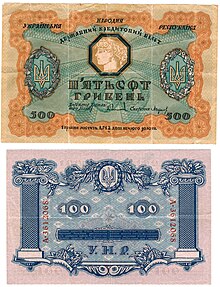
A currency called hryvna was used in Kievan Rus'. In 1917, after the Ukrainian National Republic declared independence from the Russian Empire, the name of the new Ukrainian currency became hryvnia, a revised version of the Kievan Rus' hryvna. The designer was Heorhiy Narbut.
The hryvnia replaced the karbovanets during the period September 2–16, 1996, at a rate of 1 hryvnia = 100,000 karbovantsiv. The karbovanets was subject to hyperinflation in the early 1990s following the collapse of the USSR.
To a large extent, the introduction of hryvnia was secretive.[3] Hryvnia was introduced according to President's Decree dated August 26, 1996, published on August 29. During the transition period, September 2–16, both hryvnia and karbovanets were used in circulation, but merchants were required to give change only in hryvnias. All bank accounts were converted to hryvnia automatically. During the transition period, 97% of karbovanets were taken out of circulation, including 56% in the first 5 days of the currency reform.[3] After September 16, 1996, the remaining karbovanets were allowed to be exchanged to hryvnias in banks.
The hryvnia was introduced during the period when Victor Yushchenko was the Chairman of National Bank of Ukraine. However, the first banknotes issued bore the signature of the previous National Bank Chairman, Vadym Hetman, who resigned back in 1993, because the first notes had been printed as early as 1992 by the Canadian Bank Note Company, but it was decided to delay their circulation until the hyperinflation in Ukraine was brought under control.
Initially, the foreign exchange rate was UAH 1.76 = USD 1.00. Following the Asian financial crisis in 1998 the currency devaluated to UAH 5.6 = USD 1.00 in February 2000. Later, the exchange rate remained relatively stable at around 5.4 hryvnias for 1 US dollar and was fixed to 5.05 hryvnias for 1 US dollar from 21 April 2005 until 21 May 2008. In mid-October 2008 rapid devaluation began with the hryvnia dropping 38.4% from UAH 4.85 for USD 1 on 23 September 2008 to UAH 7.88 for USD 1 on 19 December 2008.[4] After a period of instability, a new peg of 8 hryvnias per US dollar was established, and remained for several years. In 2012, the peg was changed to a managed float (much like that of the Chinese yuan) as the euro and other European countries' currencies weakened against the dollar due to the problems in Greece, and the value in mid-2012 was about 8.14 hrn per dollar.
동전[편집]
동전은 먼저 새 통화를 위해 1992년에 주조되었지만 1996년까지 도입되지 않았다. 동전은 처음에 이탈리아 조폐국와 마찬가지로[5] 루한스크 카트리지 공장(Luhansk Cartridge Factory)에서 생산되었다.[6] In addition to those listed below which were released into circulation, 15 kopiyok coins were struck in both brass and aluminium[출처 필요].
| 현재 유통중인 동전 [1] | ||||||||||
|---|---|---|---|---|---|---|---|---|---|---|
| 그림 | 가치 | 기술적 특성 | 설명 | 첫 번째 주조 날짜 | ||||||
| 뒷면 | 앞면 | 지름 | 두께 | 무게 | 구성 | 모서리 | 앞면 | 뒷면 | ||
| 1 kopiyka | 16 mm | 1.2 mm | 1.5 g | Stainless steel | Plain | Ukrainian Trident | Value | 1992 | ||

|
2 kopiyky | 17.3 mm | 1.2 mm | 0.64 or 1.8 g | Aluminium (1992–1996) and stainless steel (2001-) | |||||

|
5 kopiyok | 24 mm | 1.5 mm | 4.3 g | Stainless steel | Reeded | ||||
| 10 kopiyok | 16.3 mm | 1.25 mm | 1.7 g | Brass (1992–1996) and aluminium bronze (2001-) | Reeded | Ukrainian Trident | Value | 1992 | ||

|
25 kopiyok | 20.8 mm | 1.35 mm | 2.9 g | Reeded and plain sectors | |||||

|
50 kopiyok | 23 mm | 1.55 mm | 4.2 g | ||||||
| 1 hryvnia | 26 mm | 1.85 mm | 7.1 or 6.9 g | Inscription: "ОДНА ГРИВНЯ", 주조 년도 | ||||||
Banknotes[편집]
In 1996, the first series of hryvnia banknotes was introduced into circulation by the National Bank of Ukraine. They were dated 1992 and were in denominations of 1, 2, 5, 10 and 20 hryven’. The design of the banknotes was developed by Ukrainian artists Vasyl Lopata and Borys Maksymov.[6][7] One hryvnya banknotes were printed by the Canadian Bank Note Company in 1992. Two, five and ten hryvnya banknotes were printed two years later. Until introduction into circulation the banknotes were kept in Canada.[6]
Banknotes of the first series in denominations of 50 and 100 hryven' also existed but due to some reasons they were never introduced.
Also in 1996, the 1, 50, and 100 hryvnia notes of the second series were introduced, with 1 hryvnia dated 1994. The banknotes were designed and printed by British De La Rue.[5] Since the opening of the Mint of the National Bank of Ukraine in cooperation with De La Rue in March 1994 all banknotes have been printed in Ukraine.[5]
Later, highest denominations were added. The 200 hryvnia notes of the second series were introduced in 2001, followed by the 500 hryvnia notes of the third series in 2006.
All hryvnia banknotes issued by the National Bank continue to be a legal tender. As of 2008, the banknotes of early series can rarely be found in circulation. Also, despite the devaluing of the currency since its introduction, all kopeck coins remain in circulation, as well as all low-value hryvnia bills, including 1 hryvnia. 틀:Globalize/US As with the U.S. dollar, the 1 hryvnia bill is commonly used, and the 1 hryvnia coin is rarely seen. The 100 hryvnia denomination is quite common due to its moderately high value, much as with the US$20 bill.
First Series[편집]
| First Series [2] | ||||||||
|---|---|---|---|---|---|---|---|---|
| Image | Value | Dimensions | Main Colour | Description | Date of | |||
| Obverse | Reverse | Obverse | Reverse | first printing | issue | |||
| 1 hryvnia | 135 х 70 mm | Dark green | Vladimir I of Kiev | Ruins of Chersonesos | 1992 | September 2, 1996 | ||

|

|
2 hryvni | Brown | Yaroslav the Wise | Saint Sophia Cathedral in Kiev | |||

|

|
5 hryven' | Dark blue | Bohdan Khmelnytsky | A church in the village of Subotiv | |||

|

|
10 hryven' | Violet | Ivan Mazepa | Kiev Pechersk Lavra | |||
| 20 hryven' | Yellow and brown | Ivan Franko | Lviv Opera and Ballet Theater | |||||
| 틀:Standard banknote table notice | ||||||||
Second Series[편집]
| Second Series [3] | ||||||||
|---|---|---|---|---|---|---|---|---|
| Image | Value | Dimensions | Main Colour | Description | Date of | |||
| Obverse | Reverse | Obverse | Reverse | first printing | issue | |||
| 1 hryvnia | 133 × 66 mm | Green and brown | Vladimir I of Kiev | Ruins of Chersonesos | 1994 | September 2, 1996 | ||
| 2 hryvni | Brown | Yaroslav the Wise | The Saint Sophia Cathedral in Kiev | 1995 | September 1, 1997 | |||
| 5 hryven' | Blue | Bohdan Khmelnytsky | A church in the Selo (village) of Subotiv. | 1994 | ||||
| 10 hryven' | Brown and yellow | Ivan Mazepa | The Holy Dormition Cathedral of the Kiev Pechersk Lavra | |||||
| 20 hryven' | Brown and green | Ivan Franko | The Lviv Opera Theater | 1995 | ||||
| 50 hryven' | Yellow and violet | Mykhailo Hrushevsky | The building of the Verkhovna Rada | Not indicated on the banknotes | September 2, 1996 | |||
| 100 hryven' | Rose and green | Taras Shevchenko (old portrait) | The Saint Sophia Cathedral in Kiev | |||||
| 200 hryven' | Blue | Lesya Ukrainka | The Entrance Tower of Lutsk Castle | August 22, 2001 | ||||
| 틀:Standard banknote table notice | ||||||||
Third Series[편집]
| Denomination [4] and dimensions | Image | Main colour | Obverse | Reverse | Date of issue | |
|---|---|---|---|---|---|---|
| 1 hryvnia 118 x 63 mm |

|

|
Yellow-blue | Vladimir I of Kiev (c. 958 – 1015), Prince of Novgorod and Grand Prince of Kiev Ruler of Kievan Rus' in (980–1015) |
The fortress wall of Vladimir I in Kiev | May 22, 2006 |
| 2 hryvni 118 x 63 mm |

|

|
Peach | Yaroslav the Wise (c. 978 – 1054), Prince of Novgorod and Grand Prince of Kiev Ruler of Kievan Rus' in (1019–1054) |
The Saint Sophia's Cathedral in Kiev | September 24, 2004 |
| 5 hryven' 118 x 63 mm |

|

|
Blue | Bohdan Khmelnytsky (c. 1595 – 1657), Hetman of Ukrainia | A church in the selo (village) of Subotiv | June 14, 2004 |
| 10 hryven' 124 x 66 mm |

|

|
Crimson | Ivan Mazepa (1639 – 1709), Hetman of Ukrainia | The Holy Dormition Cathedral of the Kiev Pechersk Lavra | November 1, 2004 |
| 20 hryven' 130 x 69 mm |

|

|
Green | Ivan Franko (1856 – 1916), poet and writer | The Lviv Theatre of Opera and Ballet | December 1, 2003 |
| 50 hryven' 136 x 72 mm |
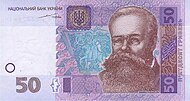
|
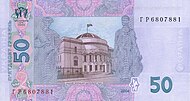
|
Violet | Mykhailo Hrushevskyi (1866 – 1934), politician and statesman | The building of the Tsentralna Rada | March 29, 2004 |
| 100 hryven' 142 x 75 mm |

|
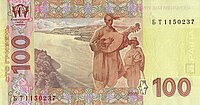
|
Olive | Taras Shevchenko (1814 – 1861), poet and artist | The Chernecha landscape near Cherkasy and the figures of a kobzar and a guide boy | February 20, 2006 |
| 200 hryven' 148 x 75 mm |

|

|
Pink | Lesya Ukrainka (1871 – 1913), poet and writer | The Entrance Tower of Lutsk Castle | May 28, 2007 |
| 500 hryven' 154 x 75 mm |
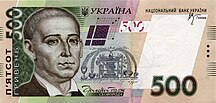
|

|
Brown | Hryhorii Skovoroda (1722 – 1794), writer and composer | The building of Kyiv Mohyla Academy | September 15, 2006 |

Exchange rates[편집]
Official NBU exchange rate at moment of introduction UAH 1.76/USD 1.[8]
In the period from 21 April 2005 through 21 October 2008 the exchange rate was pegged at around UAH 5/USD 1. In 2008 when global financial crisis hit, the hryvnia was devalued to about 8/USD 1.[9] Because of known economic problem called impossible trinity, having a fixed exchange rate and free movements of capital (i.e. cross-border lending) have undermined National Bank of Ukraine's ability to conduct independent monetary policy.
| 현재 UAH 환율 | |
|---|---|
| 구글 파이낸스: | AUD CAD CHF CNY EUR GBP HKD JPY KRW USD RUB |
| 야후! 파이낸스: | AUD CAD CHF CNY EUR GBP HKD JPY KRW USD RUB |
| XE.com: | AUD CAD CHF CNY EUR GBP HKD JPY KRW USD RUB |
| OANDA: | AUD CAD CHF CNY EUR GBP HKD JPY KRW USD RUB |
Exchange rates in Ukrainian cash currency exchangers USD/UAH EUR/UAH RUB/UAH
“Official exchange rate”. National Bank of Ukraine.
“Historical exchange rates”. National Bank of Ukraine.
See also[편집]
References[편집]
- ↑ ISO 4217 currency names and code elements
- ↑ * Michael Everson's Proposal to encode the HYRVNIA SIGN and CEDI SIGN in the UCS, 2004-04-23
- ↑ 가 나 Volodymyr Matvienko. Autograph on Hryvnia. 틀:Uk icon
- ↑ National Bank of Ukraine, historical exchange rates
- ↑ 가 나 다 “Hryvnia-Immigrant”. Dzerkalo Tyzhnia 틀:Uk icon
- ↑ 가 나 다 “How hryvnia was born”. Podrobnosti.ua (러시아어)
- ↑ “The man who designed Hryvnia”.. Dzerkalo Tyzhnia 틀:Ru icon
- ↑ http://bank.gov.ua/control/uk/curmetal/currency/search?formType=searchFormDate&time_step=daily&date=17.09.1996&execute=%D0%92%D0%B8%D0%BA%D0%BE%D0%BD%D0%B0%D1%82%D0%B8
- ↑ http://www.google.com/finance?q=USDUAH
- Krause, Chester L., and Clifford Mishler (1991). 《Standard Catalog of World Coins: 1801–1991》 18판. Krause Publications. ISBN 0873411501.
- Cuhaj, George S. (editor) (2006). 《Standard Catalog of World Paper Money: Modern Issues 1961-Present》 12판. Krause Publications. ISBN 0-89689-356-1.
External links[편집]
- History of Hryvnia
- National Bank of Ukraine announcement of Hryvnia Sign 틀:Uk icon
- Proposed symbols for hryvnia during design competition 틀:Uk icon
- Pictures of hryvnia bills introduced in 1997
- The first Ukrainian Money (1917-1922) Odessa Numismatics Museum
- Ukraine monetary reform. Numismatics 틀:Ru icon
- Ukrainian hryvnia coins catalog information
- Actual Ukrainian hryvnia exchange rates
| 전임: various |
Kyivan Rus'의 통화 11th century – 15th century |
후임: various |
| 전임: Ukrainian karbovanets |
Ukrainian People's Republic의 통화 March 1, 1918 – April, 1918 |
후임: Ukrainian karbovanets 이유: coup d'état (on April 29, 1918) |
| 전임: Ukrainian karbovanets 이유: coup d'état (on December 14, 1918) |
Ukrainian People's Republic의 통화 December, 1918 – November, 1920 |
후임: Soviet karbovanets 이유: Soviet occupation |
| 전임: Ukrainian karbovanets 이유: inflation (on September 2, 1996) 비율: 1 hryvnia = 100 000 karbovanets |
Ukraine의 통화 September 2, 1996 – |
후임: 현재 |

